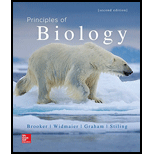
Principles of Biology
2nd Edition
ISBN: 9781259875120
Author: Robert Brooker, Eric P. Widmaier Dr., Linda Graham Dr. Ph.D., Peter Stiling Dr. Ph.D.
Publisher: McGraw-Hill Education
expand_more
expand_more
format_list_bulleted
Question
Chapter 36.9, Problem 1CC
Summary Introduction
To discuss:
The change in the oxygen-hemoglobin dissociation curve when the person is infused with HCO3- at resting position.
Introduction:
Hemoglobin brings oxygen from the lungs to the tissues of the body in red blood cells and returns carbon dioxide to the lungs from the tissues. Hemoglobin consists of four connected protein molecules (globulin chains).
Expert Solution & Answer
Want to see the full answer?
Check out a sample textbook solution
Students have asked these similar questions
Give only the mode of inheritance consistent with all three pedigrees and only two reasons that support this, nothing more, (it shouldn't take too long)
O
Describe the principle of homeostasis.
Chapter 36 Solutions
Principles of Biology
Ch. 36.1 - Prob. 1CCCh. 36.1 - Prob. 1TYKCh. 36.1 - Prob. 2TYKCh. 36.2 - Prob. 1BCCh. 36.2 - Prob. 1TYKCh. 36.2 - Which is false? Platelets are nucleated cells that...Ch. 36.3 - Prob. 1CCCh. 36.3 - Prob. 2CCCh. 36.3 - Prob. 3CCCh. 36.3 - Prob. 1TYK
Ch. 36.3 - Prob. 2TYKCh. 36.4 - Prob. 1CCCh. 36.4 - Prob. 1TYKCh. 36.4 - Prob. 2CCCh. 36.4 - Prob. 2TYKCh. 36.5 - Prob. 1TYKCh. 36.5 - Prob. 2TYKCh. 36.6 - Prob. 1TYKCh. 36.7 - Prob. 1CCCh. 36.7 - Prob. 1BCCh. 36.7 - Prob. 2CCCh. 36.7 - Prob. 3CCCh. 36.7 - Prob. 1TYKCh. 36.7 - Which of the following statements is false? The...Ch. 36.8 - Prob. 1TYKCh. 36.8 - Prob. 2TYKCh. 36.9 - Prob. 1CCCh. 36.9 - Prob. 1TYKCh. 36.9 - Prob. 2TYKCh. 36.10 - Prob. 1BCCh. 36.10 - Prob. 1TYKCh. 36.11 - Prob. 1TYKCh. 36.11 - Prob. 2TYKCh. 36.11 - Prob. 3TYKCh. 36 - Prob. 1TYCh. 36 - Prob. 2TYCh. 36 - Prob. 3TYCh. 36 - Prob. 4TYCh. 36 - Considering blood flow through a closed...Ch. 36 - Prob. 6TYCh. 36 - Prob. 7TYCh. 36 - Prob. 8TYCh. 36 - Prob. 9TYCh. 36 - Prob. 10TYCh. 36 - Discuss the difference between closed and open...Ch. 36 - Prob. 2CCQCh. 36 - Prob. 3CCQCh. 36 - Prob. 1CBQCh. 36 - List the components of the mammalian respiratory...
Knowledge Booster
Similar questions
- Explain how the hormones of the glands listed below travel around the body to target organs and tissues : Pituitary gland Hypothalamus Thyroid Parathyroid Adrenal Pineal Pancreas(islets of langerhans) Gonads (testes and ovaries) Placentaarrow_forwardWhat are the functions of the hormones produced in the glands listed below: Pituitary gland Hypothalamus Thyroid Parathyroid Adrenal Pineal Pancreas(islets of langerhans) Gonads (testes and ovaries) Placentaarrow_forwardDescribe the hormones produced in the glands listed below: Pituitary gland Hypothalamus Thyroid Parathyroid Adrenal Pineal Pancreas(islets of langerhans) Gonads (testes and ovaries) Placentaarrow_forward
- Please help me calculate drug dosage from the following information: Patient weight: 35 pounds, so 15.9 kilograms (got this by dividing 35 pounds by 2.2 kilograms) Drug dose: 0.05mg/kg Drug concentration: 2mg/mLarrow_forwardA 25-year-old woman presents to the emergency department with a 2-day history of fever, chills, severe headache, and confusion. She recently returned from a trip to sub-Saharan Africa, where she did not take malaria prophylaxis. On examination, she is febrile (39.8°C/103.6°F) and hypotensive. Laboratory studies reveal hemoglobin of 8.0 g/dL, platelet count of 50,000/μL, and evidence of hemoglobinuria. A peripheral blood smear shows ring forms and banana-shaped gametocytes. Which of the following Plasmodium species is most likely responsible for her severe symptoms? A. Plasmodium vivax B. Plasmodium ovale C. Plasmodium malariae D. Plasmodium falciparumarrow_forwardStandard Concentration (caffeine) mg/L Absorbance Reading 10 0.322 20 0.697 40 1.535 60 2.520 80 3.100arrow_forward
- please draw in the answers, thank youarrow_forwarda. On this first grid, assume that the DNA and RNA templates are read left to right. DNA DNA mRNA codon tRNA anticodon polypeptide _strand strand C с A T G A U G C A TRP b. Now do this AGAIN assuming that the DNA and RNA templates are read right to left. DNA DNA strand strand C mRNA codon tRNA anticodon polypeptide 0 A T G A U G с A TRParrow_forwardplease answer all question below with the following answer choice, thank you!arrow_forward
arrow_back_ios
SEE MORE QUESTIONS
arrow_forward_ios
Recommended textbooks for you
 Human Physiology: From Cells to Systems (MindTap ...BiologyISBN:9781285866932Author:Lauralee SherwoodPublisher:Cengage Learning
Human Physiology: From Cells to Systems (MindTap ...BiologyISBN:9781285866932Author:Lauralee SherwoodPublisher:Cengage Learning Principles Of Radiographic Imaging: An Art And A ...Health & NutritionISBN:9781337711067Author:Richard R. Carlton, Arlene M. Adler, Vesna BalacPublisher:Cengage Learning
Principles Of Radiographic Imaging: An Art And A ...Health & NutritionISBN:9781337711067Author:Richard R. Carlton, Arlene M. Adler, Vesna BalacPublisher:Cengage Learning


Human Physiology: From Cells to Systems (MindTap ...
Biology
ISBN:9781285866932
Author:Lauralee Sherwood
Publisher:Cengage Learning




Principles Of Radiographic Imaging: An Art And A ...
Health & Nutrition
ISBN:9781337711067
Author:Richard R. Carlton, Arlene M. Adler, Vesna Balac
Publisher:Cengage Learning